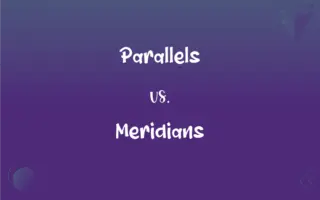To vs. With: What's the Difference?
Edited by Aimie Carlson || By Janet White || Published on February 29, 2024
"To" is used for expressing direction or destination, while "with" indicates accompaniment, manner, or means.

Key Differences
"To" is used to express direction towards a place, person, or thing (e.g., going to the store). Conversely, "with" indicates accompaniment or presence alongside something or someone (e.g., walking with a friend).
"To" often denotes purpose or intention (e.g., a key to success). In contrast, "with" suggests a method or means (e.g., writing with a pen), indicating the tool or instrument used.
When "to" is used, it implies a destination or end point of movement (e.g., sent a letter to her). "With" is used to imply inclusion, as in being part of a group or combined with something else (e.g., coffee with sugar).
"To" can indicate a relationship between different elements (e.g., a threat to peace). "With" is used to express a relationship where elements are together or interacting (e.g., friends with benefits).
"To" is often used to indicate the recipient of an action (e.g., gave the book to him). "With" indicates someone or something is accompanying or is involved in the action (e.g., dancing with enthusiasm).
ADVERTISEMENT
Comparison Chart
Usage
Direction, destination
Accompaniment, manner
Example Context
Going to a place
Doing something with someone/something
Conveys
Purpose, intention
Means, method
Typical Structure
Verb + to + noun/gerund
Verb + with + noun
Relationship Indication
Between actions, elements
Inclusion, presence with something
ADVERTISEMENT
To and With Definitions
To
Purpose.
Key to success.
With
Inclusion.
Tea with sugar.
To
Recipient.
Gave flowers to her.
With
Partnership.
Collaborating with colleagues.
To
Destination.
Travel to Spain.
With
Accompaniment.
Singing with joy.
To
Direction.
Walk to the park.
With
Method.
Writing with a pen.
To
Relationship.
Threat to stability.
With
Condition.
Dealing with challenges.
To
In a direction toward so as to reach
Went to the city.
With
In the company of; accompanying
Did you go with her?.
To
Towards
Turned to me.
With
Next to; alongside of
Stood with the rabbi.
Sat with the family.
FAQs
Is 'with' used to show companionship?
Yes, it often indicates doing something alongside someone or something.
How is 'with' used differently than 'to'?
'With' typically indicates accompaniment, method, or inclusion.
Can 'to' denote intention?
Yes, it can express purpose or intention.
Does 'to' come before a destination?
Yes, it precedes the destination or end point.
In what context is 'to' used with a verb?
Often with infinitives, like 'to run'.
What does 'to' indicate in a sentence?
It often indicates direction, destination, or purpose.
Can 'with' indicate the tool used in an action?
Yes, it shows the means or instrument used.
What role does 'to' play in formal invitations?
It specifies the person being invited, as in 'to John Smith'.
What does 'with' imply in a phrase like 'with respect'?
It indicates the manner in which an action is done.
How is 'with' used in the context of conditions or states?
It can describe experiencing or having a particular condition, like 'with enthusiasm'.
Does 'to' always indicate physical movement?
Not always, it can also denote metaphorical movement or direction.
Can 'with' be used to indicate cooperation?
Yes, like in 'working with a team'.
Can 'to' be used to indicate time?
Yes, as in 'ten to five' (meaning 4:50).
How does 'to' function in infinitive verb forms?
It forms the infinitive, like 'to eat' or 'to sleep'.
Does 'to' indicate the recipient in gift-giving?
Yes, as in 'give a gift to a friend'.
How does 'with' function in phrases about health?
It's used to indicate having a condition, like 'diagnosed with'.
How does 'to' function in expressing relationships?
It can show the relationship or connection between things.
Is 'with' used in expressions of emotions?
Yes, such as 'angry with someone' or 'happy with the results'.
Can 'with' be used to indicate opposition?
Yes, in phrases like 'arguing with someone'.
Is 'with' used to describe physical proximity?
Yes, it can denote physical closeness or involvement.
About Author
Written by
Janet WhiteJanet White has been an esteemed writer and blogger for Difference Wiki. Holding a Master's degree in Science and Medical Journalism from the prestigious Boston University, she has consistently demonstrated her expertise and passion for her field. When she's not immersed in her work, Janet relishes her time exercising, delving into a good book, and cherishing moments with friends and family.
Edited by
Aimie CarlsonAimie Carlson, holding a master's degree in English literature, is a fervent English language enthusiast. She lends her writing talents to Difference Wiki, a prominent website that specializes in comparisons, offering readers insightful analyses that both captivate and inform.







































































